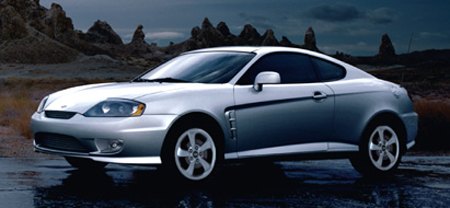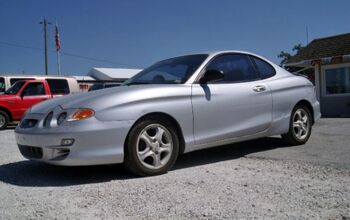Hyundai Tiburon Tuscani Review
Tuscany. The name evokes images of dining al-fresco in pastel stucco courtyards watching sleek 12-cylinder convertibles cruise by, their impossibly chic passengers hiding behind oversized shades. Tuscani. The name evokes an automotive product that wants to proclaim Italian flare but doesn’t have the necessary accent or copyright. To those who delight in unmasking fake Rolexes and other pretentious twaddle, the Tuscani is an instant classic: a car that pays homage to a Ferrari 456 GT made in South Korea.
Strange but true: the Tuscani is a top spec Hyundai Tiburon. Since gen one’s ‘96 debut, the Tiburon has metamorphosed from cheap and cheesy import with bloated body lines, whale-tail spoiler and older, Acura-like double headlights; to striking Italian supercar knock off. The Tuscani’s hood is convincingly long, the deck credibly short and the stance convincingly wide and aggressive. There’s even a perky chiseled rump bringing up the rear (literally). And for no extra money (or cred), the bodacious booty hides a hatch.
“Tiburon” is Spanish for "shark”– which accounts for the gill-like vents behind the Tuscani’s front fenders. Side cut line creases and a high beltline add edginess to the pastiche and slenderize the body. For those paying attention to such things, weedy dual chrome exhausts and a “racing-inspired” fuel door provide some clean air between Korea’s budget knock-off and Ferrari’s Our Lady of Unfathomable Depreciation. While the Hyundai’s split spoke five-spokes mock the Ferrari’s pentagrams, the dual piston performance calipers (front) peeking out fron the Tuscani's wheels are exactly the kind of homage we encourage.
Once inside, the center stack immediately identifies the Tuscani’s target market: boy racers. The gauges feature sporty red-on-black markings (it’s the only Hyundai I've ever driven without Mountain Dew colored backlighting). Drivers also "enjoy" a trio of analogue dials measuring torque (in Newton meters), voltage and real time fuel consumption. Humongous circular air vents crown these stylishly useless displays like misplaced periscopes. Faux titanium brightens up the dour interior while faux aluminum adds a faux racing touch to the pedals.
Recaro seats with tasty red stitching coddle G-force jockeys with plenty of bolstering. Even so, tall, long-legged drivers will find it nearly impossible to achieve a spinal friendly driving position; the Tuscani’s front headroom is almost as limited as rear legroom (but not quite). The upside: the rear seats fold down to create a voluminous cargo space and the hatch opens wide enough to stow most anything (bungee cords and red flag optional).
The gear shifter looks like nothing so much as a ribbed play toy from the naughty store. The gates are as nebulous as a Car and Driver editorial, bereft of that dead-certain snickery familiar to drivers of Japan’s– or Maranello’s– finest. Urban Tuscani drivers face this shortcoming on a regular basis, what with the six-speed gearbox clamoring for constant attention. The Tuscani provides a textbook example of how not to space your gears; first and second are gone in a blink, sixth is for fuel conservation only.
The base model Tiburon is motivated by a 2.0-liter four. The all options checked Tuscani is powered by Hyundai’s 2.7-liter, DOHC six-cylinder engine. Although peak power (172 horsepower) arrives at a lofty 6000rpm, the V6 is smooth, quiet and torquey. But not quick. The 2939 pound [no-rear-seats-to-speak-of] coupe journeys from rest to sixty-two miles per hour in a leisurely 7.8 seconds– not bad for a Dadmobile, but laughable for a wanna-be Ferraristi. The wait for forward momentum may be long, but the interval between braking and stopping isn’t. The Tuscani is blessed with some of the most powerful brakes I’ve ever tested on a road car. Period.
Unfortunately, the Tuscani is the machine that puts pay to the old axiom that a car is only as good as its brakes. The car's steering is too heavy, the torque steer too prominent and the “sports-tuned” suspension too unsportsmanlike to generate any fun worthy of serious stopping. There’s plenty of after-market support for better handling and a vast supply of body kits (from the sublime to surreal) to transform this pseduo-Euro coupe into a Fast & Furious rice rocket. But you can’t make a silk purse– or a baby Ferrari– out of a front wheel-drive sow’s ear.
Conversely, if the Tiburon/Tuscani was a real-wheel drive car, its enthusiast fan-base would explode. Speculation on a rear wheel-drive Tiberon on the message boards runs rampant, fueled by an acknowledgement of the possibility by Hyundai president Hyun Soon. When? Don’t make me say it. Anyway, a more powerful RWD Hyundai performance coupe would offer vehicles like the Mazda RX8 so real competition. A free-revving, right wheel-drive Tuscani would also deliver the kind of powerful performance and electric handling its exotic Euro-flavored looks deserve. Ish.
Gearhead, newspaper grunt, car writer, illustrator: http://www.auto123.com/en/info/news/ourwriters,front.spy www.CanadianDriver.com www.painkillerz.ca
More by Lesley Wimbush
Latest Car Reviews
Read moreLatest Product Reviews
Read moreRecent Comments
- 3-On-The-Tree 2014 Ford F150 Ecoboost 3.5L. By 80,000mi I had to have the rear main oil seal replaced twice. Driver side turbo leaking had to have all hoses replaced. Passenger side turbo had to be completely replaced. Engine timing chain front cover leak had to be replaced. Transmission front pump leak had to be removed and replaced. Ford renewed my faith in Extended warranty’s because luckily I had one and used it to the fullest. Sold that truck on caravan and got me a 2021 Tundra Crewmax 4x4. Not a fan of turbos and I will never own a Ford again much less cars with turbos to include newer Toyotas. And I’m a Toyota guy.
- Duke Woolworth Weight 4800# as I recall.
- Kwik_Shift_Pro4X '19 Nissan Frontier @78000 miles has been oil changes ( eng/ diffs/ tranny/ transfer). Still on original brakes and second set of tires.
- ChristianWimmer I have a 2018 Mercedes A250 with almost 80,000 km on the clock and a vintage ‘89 Mercedes 500SL R129 with almost 300,000 km.The A250 has had zero issues but the yearly servicing costs are typically expensive from this brand - as expected. Basic yearly service costs around 400 Euros whereas a more comprehensive servicing with new brake pads, spark plugs plus TÜV etc. is in the 1000+ Euro region.The 500SL servicing costs were expensive when it was serviced at a Benz dealer, but they won’t touch this classic anymore. I have it serviced by a mechanic from another Benz dealership who also owns an R129 300SL-24 and he’ll do basic maintenance on it for a mere 150 Euros. I only drive the 500SL about 2000 km a year so running costs are low although the fuel costs are insane here. The 500SL has had two previous owners with full service history. It’s been a reliable car according to the records. The roof folding mechanism needs so adjusting and oiling from time to time but that’s normal.
- Theflyersfan I wonder how many people recalled these after watching EuroCrash. There's someone one street over that has a similar yellow one of these, and you can tell he loves that car. It was just a tough sell - too expensive, way too heavy, zero passenger space, limited cargo bed, but for a chunk of the population, looked awesome. This was always meant to be a one and done car. Hopefully some are still running 20 years from now so we have a "remember when?" moment with them.





































Comments
Join the conversation
People need to chill with the VR6. That thing was slow as hell
Hey guys. Thanks soo much for the information. Am about to buy this car and wanted to know the durability of this car as well as the consumption . There are very few in our town and i wonder why people dont buy the car since its relatively cheap. What are some of the problems that i might experience after buying this car?